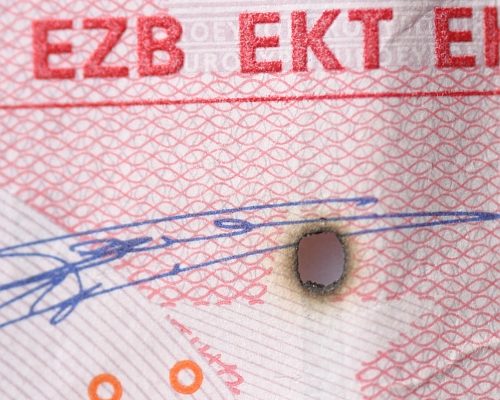RFID Technology fur Use in Currency Becomes More Sophisticated
The 500 euro banknote barely circulates in Europe – this is to say, it is rarely seen in everyday commerce. However, it does exist, and makes the handling of large amounts of cash easier. Not surprisingly, it is said to be highly popular with various criminal organizations, although as far as we are aware, there is no hard evidence of this. Rather, it seems to be an assumption, if a sensible one.
Hitherto, the ECB was mainly interested in the possibility of employing RFID tags in banknotes for security reasons (to make forging them more difficult), and as passive tracking devices, ostensibly in order to be able to track money used by organized crime so as to prevent money laundering.

10 euro bill after 10 secs of microwave treatment
Image via dvd-svcd-forum.de
Work on this ‘feature’ started in 2001 already:
“In 2001, the European Central Bank started working with technology partners on a hush-hush project to embed radio frequency identification tags into the very fibers of euro banknotes by 2005. The ECB was deeply concerned about counterfeiting and money laundering. Counterfeiting of euro notes has been a problem in Greece and there have been cases in the new member countries too. In 2003, Greek authorities were confronted with of 2,411 counterfeiting cases and seized 4,776 counterfeit banknotes while authorities in Poland nabbed a gang suspected of making and putting over a million fake euros into circulation. Money laundering was also an issue of increasing concern, and that was probably one of the reasons that the higher denominations were considered for tagging (€200 and €500 notes).
Although euro banknotes already include such security features as holograms, foil stripes, special threads, microprinting, special inks and watermarks, the ECB believes it must add further protection to keep the euro from becoming the currency of choice in the criminal underworld.Among the current security features are threads visible under ultraviolet light, but businesses and stores often find it hard to judge a note’s authenticity, as current equipment seldom can tell the difference between false currency and old notes with worn-out security marks. The ECB has contacted various central banks worldwide – not just in Europe – to discuss added security measures for the currency.â€

Al Capone allegedly laundered $1 billion through a variety of legitimate business ventures. His first business operations indeed consisted of laundromats, which were quite useful in hiding and disguising illegal income because they were cash operated. It is possible that Capone’s use of laundromats actually explains the origin of the phrase “money launderingâ€.

